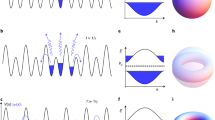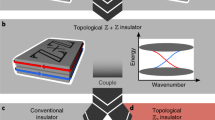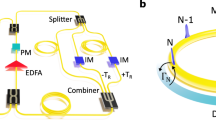Abstract
A remarkable property of quantum mechanics in two-dimensional space is its ability to support ‘anyons’, particles that are neither fermions nor bosons. Theory predicts that these exotic excitations can exist as bound states confined near topological defects, such as Majorana zero modes trapped in vortices in topological superconductors. Intriguingly, in the simplest cases the non-trivial phase that arises when such defects are ‘braided’ around one another is not intrinsically quantum mechanical; instead, it can be viewed as a manifestation of the geometric (Pancharatnam–Berry) phase in wave mechanics, which makes possible the simulation of such phenomena in classical systems. Here, we report the experimental measurement of the geometric phase owing to such a braiding process. These measurements are obtained with an interferometer constructed from highly tunable two-dimensional arrays of photonic waveguides. Our results introduce photonic lattices as a versatile platform for the experimental study of topological defects and their braiding, and complement ongoing efforts in the study of solid-state systems and cold atomic gases.
This is a preview of subscription content, access via your institution
Access options
Access Nature and 54 other Nature Portfolio journals
Get Nature+, our best-value online-access subscription
$29.99 / 30 days
cancel any time
Subscribe to this journal
Receive 12 print issues and online access
$209.00 per year
only $17.42 per issue
Buy this article
- Purchase on Springer Link
- Instant access to full article PDF
Prices may be subject to local taxes which are calculated during checkout



Similar content being viewed by others
Data availability
The data that support the findings of this study are available from the corresponding author on reasonable request.
References
Leinaas, J. & Myrheim, J. On the theory of identical particles. Nuovo Ciment. B 37, 1–23 (1977).
Wilczek, F. Magnetic flux, angular momentum, and statistics. Phys. Rev. Lett. 48, 1144–1146 (1982).
Wilczek, F. Quantum mechanics of fractional-spin particles. Phys. Rev. Lett. 49, 957–959 (1982).
Fröhlich, J. Statistics of fields, the Yang-Baxter equation, and the theory of knots and links. In Nonperturbative Quantum Field Theory (eds ‘t Hooft, G., et al.), NATO ASI Ser. B 185, 71–100 (Springer, 1988).
Witten, E. Quantum field theory and the Jones polynomial. Commun. Math. Phys. 121, 351–399 (1989).
Nayak, C., Simon, S. H., Stern, A., Freedman, M. & Das Sarma, S. Non-Abelian anyons and topological quantum computation. Rev. Mod. Phys. 80, 1083–1159 (2008).
Freedman, M., Kitaev, A., Larsen, M. & Wang, Z. Topological quantum computation. Bull. Am. Math. Soc. 40, 31–38 (2002).
Kitaev, A. Fault-tolerant quantum computation by anyons. Ann. Phys. 303, 2–30 (2003).
Halperin, B. I. Statistics of quasiparticles and the hierarchy of fractional quantized Hall states. Phys. Rev. Lett. 52, 1583–1586 (1984).
Arovas, D., Schrieffer, J. R. & Wilczek, F. Fractional statistics and the quantum Hall effect. Phys. Rev. Lett. 53, 722–723 (1984).
Todorić, M., Jukić, D., Radić, D., Soljačić, M. & Buljan, H. Quantum Hall effect with composites of magnetic flux tubes and charged particles. Phys. Rev. Lett. 120, 267201 (2018).
Lunić, F. et al. Exact solutions of a model for synthetic anyons in a noninteracting system. Phys. Rev. B 101, 115139 (2020).
Camino, F. E., Zhou, W. & Goldman, V. J. Realization of a Laughlin quasiparticle interferometer: observation of fractional statistics. Phys. Rev. B 72, 075342 (2005).
An, S., et al., Braiding of Abelian and non-Abelian anyons in the fractional quantum Hall effect. Preprint at http://arXiv.org/abs/1112.3400 (2011).
Willett, R. L., Nayak, C., Shtengel, K., Pfeiffer, L. N. & West, K. W. Magnetic-field-tuned Aharonov–Bohm oscillations and evidence for non-Abelian anyons at ν = 5/2. Phys. Rev. Lett. 111, 186401 (2013).
Nakamura, J. et al. Aharonov–Bohm interference of fractional quantum Hall edge modes. Nat. Phys. 15, 563–569 (2019).
Aasen, D. et al. Milestones toward Majorana-based quantum computing. Phys. Rev. X 6, 031016 (2016).
Karzig, T. et al. Scalable designs for quasiparticle-poisoning-protected topological quantum computation with Majorana zero modes. Phys. Rev. B 95, 235305 (2017).
Bartolomei, H. et al. Fractional statistics in anyon collisions. Science 368, 173–177 (2020).
Nakamura, J., Liang, S., Gardner, G. C. & Manfra, M. J. Direct observation of anyonic braiding statistics at the ν = 1/3 fractional quantum Hall state. Preprint at https://arxiv.org/abs/2006.14115 (2020).
Pancharatnam, S. Generalized theory of interference, and its applications. Part I. Coherent pencils. Proc. Indian Acad. Sci. A 44, 247–262 (1956).
Berry, M. Quantal phase factors accompanying adiabatic changes. Proc. R. Soc. Lond. A 392, 45–57 (1984).
Berry, M. The adiabatic phase and Pancharatnam’s phase for polarized light. J. Mod. Opt. 34, 1401–1407 (1987).
Ivanov, D. A. Non-Abelian statistics of half-quantum vortices in p-wave superconductors. Phys. Rev. Lett. 86, 268–271 (2001).
Haldane, F. D. M. & Raghu, S. Possible realization of directional optical waveguides in photonic crystals with broken time-reversal symmetry. Phys. Rev. Lett. 100, 013904 (2008).
Wang, Z., Chong, Y., Joannopoulos, J. & Soljačić, M. Observation of unidirectional backscattering-immune topological electromagnetic states. Nature 461, 772–775 (2009).
Rechtsman, M. C. et al. Photonic Floquet topological insulators. Nature 496, 196–200 (2013).
Hafezi, M., Mittal, S., Fan, J., Migdall, A. & Taylor, J. M. Imaging topological edge states in silicon photonics. Nat. Photonics 7, 907–912 (2013).
Ozawa, T. et al. Topological photonics. Rev. Mod. Phys. 91, 015006 (2019).
Yang, Y. et al. Synthesis and observation of non-Abelian gauge fields in real space. Science 365, 1021–1025 (2019).
Davis, K. M., Miura, K., Sugimoto, N. & Hirao, K. Writing waveguides in glass with a femtosecond laser. Opt. Lett. 21, 1729–1731 (1996).
Szameit, A. & Nolte, S. Discrete optics in femtosecond-laser-written photonic structures. J. Phys. B–At. Mol. Opt. 43, 163001 (2010).
Iadecola, T., Schuster, T. & Chamon, C. Non-Abelian braiding of light. Phys. Rev. Lett. 117, 073901 (2016).
Chiu, C. -K., Teo, J. C. Y., Schnyder, A. P. & Ryu, S. Classification of topological quantum matter with symmetries. Rev. Mod. Phys. 88, 035005 (2016).
Hou, C. -Y., Chamon, C. & Mudry, C. Electron fractionalization in two-dimensional graphenelike structures. Phys. Rev. Lett. 98, 186809 (2007).
Jackiw, R. & Rossi, P. Zero modes of the vortex-fermion system. Nucl. Phys. B 190, 681–691 (1981).
Teo, J. C. Y. & Kane, C. L. Topological defects and gapless modes in insulators and superconductors. Phys. Rev. B 82, 115120 (2010).
Semenoff, G. W. Chiral symmetry breaking in graphene. Phys. Scr. T146, 014016 (2012).
Read, N. & Green, D. Paired states of fermions in two dimensions with breaking of parity and time-reversal symmetries and the fractional quantum Hall effect. Phys. Rev. B 61, 10267–10297 (2000).
Fu, L. & Kane, C. L. Superconducting proximity effect and Majorana fermions at the surface of a topological insulator. Phys. Rev. Lett. 100, 096407 (2008).
Izutsu, M., Nakai, Y. & Sueta, T. Operation mechanism of the single-mode optical-waveguide Y junction. Opt. Lett. 7, 136–138 (1982).
Hardin, R. Applications of the split-step Fourier method to the numerical solution of nonlinear and variable coefficient wave equations. SIAM Rev. 15, 423 (1973).
Guglielmon, J., Huang, S., Chen, K. P. & Rechtsman, M. C. Photonic realization of a transition to a strongly driven Floquet topological phase. Phys. Rev. A 97, 031801 (2018).
Acknowledgements
M.C.R. and J.N. acknowledge support from the US National Science Foundation (NSF, grant no. ECCS-1509546) and the Penn State Materials Research Science and Engineering Center, Center for Nanoscale Science (grant no. NSF DMR-1420620). M.C.R. acknowledges support from the US Office of Naval Research (grant no. N00014-18-1-2595) and the Packard Foundation (fellowship no. 2017-66821). J.N. acknowledges support by the Corning Incorporated Office of STEM Graduate Research. T.S. acknowledges support from the US NSF Graduate Research Fellowship Program (grant no. DGE 1752814). T.I. acknowledges support from the Laboratory for Physical Sciences, Microsoft and a Joint Quantum Institute postdoctoral fellowship, as well as Iowa State University start-up funds. K.P.C., S.H. and M.W. acknowledge support from the US NSF (grant nos. ECCS-1509199 and DMS-1620218). C.C. is supported by the US Department of Energy (grant no. DE-FG02-06ER46316).
Author information
Authors and Affiliations
Contributions
J.N. carried out the optical probing experiment and performed data analysis with guidance from M.C.R. J.N. and T.S. performed numerical simulations and designed the sample. T.S., T.I. and C.C. performed the theoretical analysis and helped to guide the experiment. S.H. and M.W. developed the laser fabrication process and fabricated and characterized the samples under the supervision of K.P.C. The manuscript was written by J.N., T.S., T.I, C.C. and M.C.R. M.C.R. supervised the project.
Corresponding author
Ethics declarations
Competing interests
The authors declare no competing interests.
Additional information
Publisher’s note Springer Nature remains neutral with regard to jurisdictional claims in published maps and institutional affiliations.
Supplementary information
Supplementary Video 1
Movies of the two waveguide lattices throughout the braiding stage, with each frame representing a constant-z slice of the waveguide array. The waveguides (filled circles) are displaced from their honeycomb positions (empty circles) at an angle equal to the phase of the Kekulé order parameter Δr(z) (arrows, drawn parallel to the displacements and colored according to their orientation). The order parameter in each lattice contains a vortex of charge –1 (central red square) near the lattice center. The overall offset α of the order parameter’s phase in each lattice is varied as a function of z and can be interpreted as the angle between the central anti-vortex and a fictitious vortex ‘at infinity’ (outer red square) that resides outside the waveguide array. In this first experiment, α → α + π in both lattices, corresponding to braiding a vortex at infinity counterclockwise about each lattice.
Supplementary Video 2
In this second experiment, α → α + π in the lattice on the left, and α → α − π in the lattice on the right, corresponding to braiding a vortex at infinity counterclockwise about the left lattice but clockwise about the right lattice. The final configurations of the two lattices differ by a phase 2π and are identical.
Rights and permissions
About this article
Cite this article
Noh, J., Schuster, T., Iadecola, T. et al. Braiding photonic topological zero modes. Nat. Phys. 16, 989–993 (2020). https://doi.org/10.1038/s41567-020-1007-5
Received:
Accepted:
Published:
Issue Date:
DOI: https://doi.org/10.1038/s41567-020-1007-5
This article is cited by
-
Observation of vortex-string chiral modes in metamaterials
Nature Communications (2024)
-
Topological phenomena at defects in acoustic, photonic and solid-state lattices
Nature Reviews Physics (2023)
-
Photonic Majorana quantum cascade laser with polarization-winding emission
Nature Communications (2023)
-
A second wave of topological phenomena in photonics and acoustics
Nature (2023)
-
Non-Abelian effects in dissipative photonic topological lattices
Nature Communications (2023)



